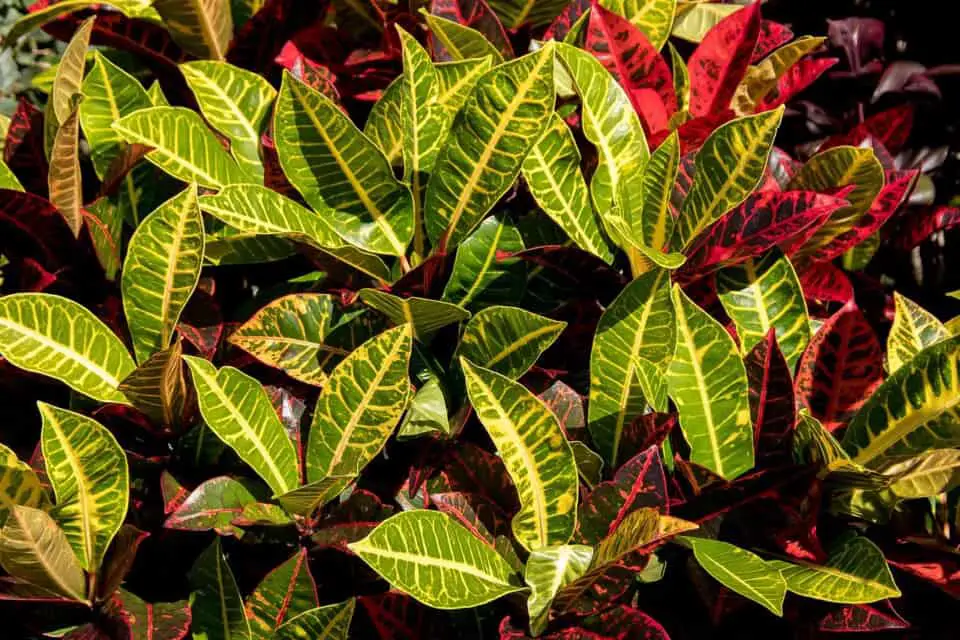Some links in the post are affiliate links and I get a commission from purchases made through some links found in the post.
How much thought do you give to the potting mix you use for your plants? Until a while ago, I almost always focused on the type of fertilizer I would use in the potting mix.
I would use just about any potting mix I would find in gardening stores. Then I would add some fertilizer and would consider my job done.
And that worked for a long time. It was later that I realized that I had been lucky to choose general potting mixes for my croton because these plants are quite picky when it comes to soil.
A croton prefers light, well-aerated, and well-draining potting mixes. If the soil is not correct, a croton will show signs of stunted growth, yellowing and browning leaves.
I had not realized this and yet had grown a beautiful plant that was the envy of many. But once I figured it out, I was quick to make changes which have sustained my plant to date:
What Soil Nutrients Does a Croton Need?
 Crotons, while low-maintenance plants, are heavy feeders that need nutrients just about every other month.
Crotons, while low-maintenance plants, are heavy feeders that need nutrients just about every other month.
And for your croton to be healthy and strong, you must regularly feed it with nitrogen, phosphorus, and potassium.
It, of course, needs micronutrients like zinc, boron, and manganese to promote cellular activities and supplement the macronutrients.
Your plant needs all these nutrients from the word go, and you must thus choose a potting mix that can start feeding them to it from an early age. And to do this, you should go for a mix that contains:
- A potting soil with a light aerated texture,
- Sphagnum peat moss,
- Sand,
- Compost,
- Worm castings,
- Lime,
- Coco coir,
- Perlite, and
- Pine bark fines.
These are the basic foundations of any good potting mix for a croton. But you can always replace these ingredients with others that can serve a similar purpose.
You may also like: What is the ideal humidity for a croton
What Type of Soil Should You Use for Your Croton?
The type of soil you choose comes down to the ideal growing conditions for your croton. So, what does your croton need?
1) Moderate Drainage
While crotons do not enjoy being overwatered, they should not be left in dry soil for long periods.
As such, you should find soil that allows excess water to drain while also retaining what’s necessary. That’s where components like compost and perlite come in handy.
2) Moderate Water Retention
This argument relates to the first point. If the soil mix is too fast-draining, the croton will not have the chance to absorb water for its use.
So, you want to ensure that the mix can hold on to a substantial amount of water. Compost has a high water retention rate, and you can use it to improve this capacity.
However, use it sparingly as it can increase the retention rate so much that it paves the way for overwatering.
3) High Nutritional Profile
Besides allowing the croton access to moisture, the mix should also have adequate nutrients. These include macro and micronutrients, which you can provide in the form of compost, barks, and other organic matter.
4) Moderate Texture
The soil should neither be too compact nor too loose. Go for a texture that falls between these extremes to allow good airflow and good drainage.
Later, I will share some recipes you can use to achieve all these checks in your potting mix.
What Are the Signs You Are Using the Wrong Soil for Your Croton?
Don’t you just love how much plants express dissatisfaction with their environments?
It helps you narrow down to what’s ailing them so you can fix it and go back to enjoying their calming effect. And if you use the wrong soil for your croton, you can expect:
- Stunted growth: This is one of the most telling signs,
- Brown leaves which indicate watering problems,
- The falling of leaves due to root rot,
- Moldy growth and a foul smell from the soil, and
- Increased pest infestations owing to the favorable conditions brought on by fungal growth.
Have you noticed such signs in your potting mix or croton?
You may also like: 4 reasons your croton is turning green
What PH Should the Soil Be for A Croton?
Crotons do well in slightly acidic potting mixes. Check that the soil’s pH ranges between 4.5 and 6.5, and you will have hit the nail on the head.
To do this, you can use a home test which you can get from a gardening store.
If the pH is higher than 6.5, use acidic components like peat moss to increase its acidity. And if it’s below the range, use alkaline materials to decrease its acidity.
Our 5 Recommended Soils for A Croton
Making your croton soil mix is a good idea. But sometimes, it is much easier to get a ready blend from a trusted potting mix manufacturer and get down to business.
So, which companies can you entrust with such a vital decision? Here are my picks:
1) FoxFarm Ocean Forest Potting Soil Mix
This potting mix features a pH of 6.3 to 6.8, which your croton needs to take up adequate fertilizer.
Moreover, it has the perfect light and aerated texture that allows excess water to drain while holding on to the water the plant needs to thrive. Plus, you won’t need to feed your plant for a while after introducing this potting mix.
It boasts earthworm castings, crab meal, moss, forest hummus, bat guano, and other natural materials that will feed your croton for a long time. And the icing on the cake? – It is ready to use!
2) Miracle-Gro Indoor Potting Mix
If you are yet to use a Miracle-Gro solution, this would be the ideal chance to jump on this train. This company excels in natural solutions for houseplants, and this product is not an exception.
To start with, it does not contain compost or bark. While high in nutrients, these materials also create favorable conditions for fungus gnats.
And with them out of the equation, you can have one less concern. This potting mix comes as part of a pack that includes plant food that you can use to nourish the plant as it acclimates to its new environment.
3) Sun Gro Black Gold Moisture Supreme Container Mix
This mix features peat moss as the main ingredient, and you know what that means – you can water your croton per the right watering schedule without running into root rot.
But that’s not all that this mix has to offer you. It also comprises earthworm castings, compost, and coir, which are essential in nourishing your croton.
And you will be happy that it has high moisture retention, which reduces the number of times you need to water it.
4) Premier Premium Potting Mix
What would you say to not having to feed your croton for the next six to nine months? Most people would jump at the chance (I know I would) because feeding houseplants can often be tricky.
Thanks to the gradual-release technology used in this potting mix, that can now be a reality.
Moreover, it also has a high water retention rate that reduces the number of times you should water the plant. So, you can sit back and allow the plant to soak in the optimal nutritional profile in the mix.
5) Espoma Organic Potting Soil Mix
If you’re looking for a potting mix that works for all other potted plants in your home, this is it.
Its blend of peat moss, perlite, humus, earthworm castings, feather meal, kelp meal, and alfalfa meal is enough for your croton.
I should also add that the manufacturer does not use any synthetic plant foods or chemicals, so this would fit right in with an organic gardening theme. What’s not to love about this potting mix?
All these mixes have the earlier outlined features, which are crucial in meeting a croton’s soil needs.
Can I Use Cactus Soil for Croton?
Cactus soil is often considered a good potting mix for many houseplants. But can you use it with your croton? Cactus soil has a high moisture drainage rate.
As such, it cannot hold on to as much water as your plant may need to thrive. The options here are two. You can either write off the idea of using cactus soil for your croton or amend the soil accordingly.
Let me walk you through some of the best mixes for crotons, and you can see how you can add cactus soil to the mix:
- To give your croton mix an adequate balance of aeration and drainage, you can use:
- 10 parts peat moss,
- 5 parts perlite,
- 2 parts sandy/ loamy soil,
- 1 part lime, and
- 2 parts of worm castings.
Do any of these ingredients look familiar to what we unearthed when covering commercial mixes? Below is another good recipe.
- To create yet another equally good mix, you can use:
- 6 parts potting soil (any of the above commercial mixes can work),
- 4 parts perlite,
- 5 parts peat moss, and
- 5 parts compost.
The potting soil would be the heavier part as it would account for most of the potting mix’s water retention and aeration.
Now, how can you equate this to a cactus soil mix? Cactus soil needs more ingredients to help it with water retention. And these include:
- Potting soil,
- Compost, and
- Peat moss.
So, if you compare this to the second recipe I covered above, the cactus soil would take the place of the perlite. And so would be the case even in the first recipe.
Can you see how that works? Once you incorporate the ingredients, you can now pot your croton, knowing that overwatering and underwatering will be at bay.
You may also like: Croton light requirements
How To Repot a Croton
 Crotons grow quite fast and need repotting about once each year. But just to be sure that your plant needs a new home, you should check for signs of distress. These include:
Crotons grow quite fast and need repotting about once each year. But just to be sure that your plant needs a new home, you should check for signs of distress. These include:
- Stunted growth despite the plant getting all its basic needs met,
- Its roots sticking out of the drainage holes or sticking out of the soil surface,
- Signs of underwatering even if you often water the plant,
- Its leaves start losing their lustre and color, and
- Its roots appear rootbound and have curled inside the soil and around each other.
When your croton becomes rootbound, its roots cannot take up enough moisture and nutrients to support its growth.
So, its growth slows down, and no matter how much you feed and water it, nothing seems to change. The only way to deal with this is to repot the plant using the steps below:
1) Assess the plant to ensure that it needs repotting: Sometimes, stunted growth, discolored leaves, and dehydration owe to other plant issues.
You will want to ensure that repotting is the best approach. And to do this, you will need to wiggle the plant out of the pot and look at its roots. Do they appear curled? Are they sticking out of the soil surface or drainage holes?
2) Choose an active growing season to perform the repotting: Moving your croton to another environment can stress it.
And the effect is substantially worse in the winter and colder months when the plant is somewhat dormant. You should repot the plant in spring, summer, or early fall to allow it to acclimate before the cold weather starts.
3) Cut off any damaged parts so the plant can focus its energy on spreading in the new potting mix rather than healing these damaged sections. When cutting off any plant parts, use a sterilized and sharp tool, so you do not bruise the plant.
4) Select a pot that is one or two inches wider than the last one. Going for a much larger pot forces the plant to focus on spreading in the pot to take up space and adversely affects vertical growth.
Moreover, larger pots pave the way for overwatering and all the problems attached to it. So, go for an inch or two wider, ensuring that the pot has enough drainage holes.
5) Pour in a potting mix that meets the croton’s ideal soil conditions (water retention, drainage, pH, etc.), and
6) Wiggle the croton from its current potting mix and place it in the other potting mix. Water the soil and place the croton in a spot with bright and indirect light so it can dry.
In the days that follow, your croton may show signs of drooping. It relates to transplant stress. Keep giving it optimal growing conditions, and it will perk up within the week.
Once a few weeks or months have passed, you can get back to your usual feeding routine.
If it continues to droop, we have an article to help you on why are my croton leaves drooping.
Final Thoughts
To cap this guide, I encourage you to plant your croton in aerated and well-draining soil with good water retention.
That’s what your croton needs to be bold and healthy. And with so many good potting mixes available in the market, meeting its needs is not hard.
Happy Gardening!






